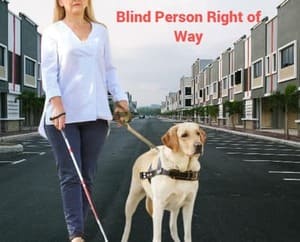A blind person legally has the right-of-way when he is
A blind person legally has the right-of-way when crossing the street when he is led by a guide dog or using a white or metallic cane. Even if the crosswalks are marked or unmarked, the traffic signals and other right-of-way rules are against him.
‘A blind person legally has the right-of-way crossing the street when is’ is a frequently asked question in DMV written test. Therefore, it is very important for you to know the right answer to pass your driving test and also become a safer driver. However, in the DMV test, this question will be three answer choices and you have to choose the correct one out of three.
Improve Your Road Signs Knowledge, Take a Free Road Signs Knowledge Test.

A blind person legally has the right-of-way when he is
Similar Questions are frequently asked in the Dmv test.
True or False: You must always yield the right of way to persons who are blind.
You must always yield the right of way to persons who are blind is true.
A blind person legally has the right-of-way when crossing the street when he is:
A blind person legally has the right-of-way when crossing the street when he is led by a guide dog or using a white or metallic cane.
When does a blind person have the right of way
A blind person legally has the right-of-way when when he is led by a guide dog or using a white or metallic cane.
This question appeared in the following DMV Tests.
Find Out More Dmv Test Questions And Answers
Driving test questions and answers about the Traffic Circle.
Dmv test questions and answers about the right of way at a 4-way stop
Driving test questions and answers about how to enter an expressway.
Can you make a complete turn at a No U-turn sign?
Do you know, what the Flagger Ahead Sign means?
Can you park your vehicle at a No Parking Sign location?
Divided highway ends sign – What does it mean?
When parking near a corner, you may park your vehicle no closer than:

